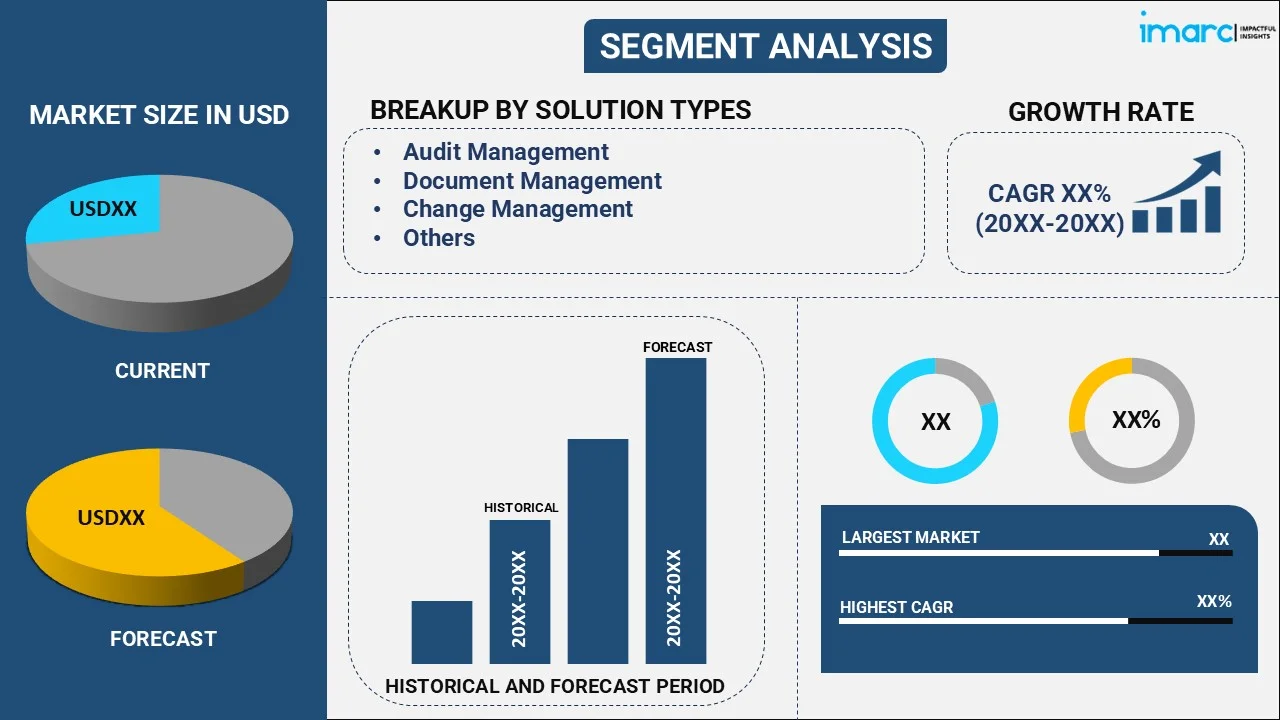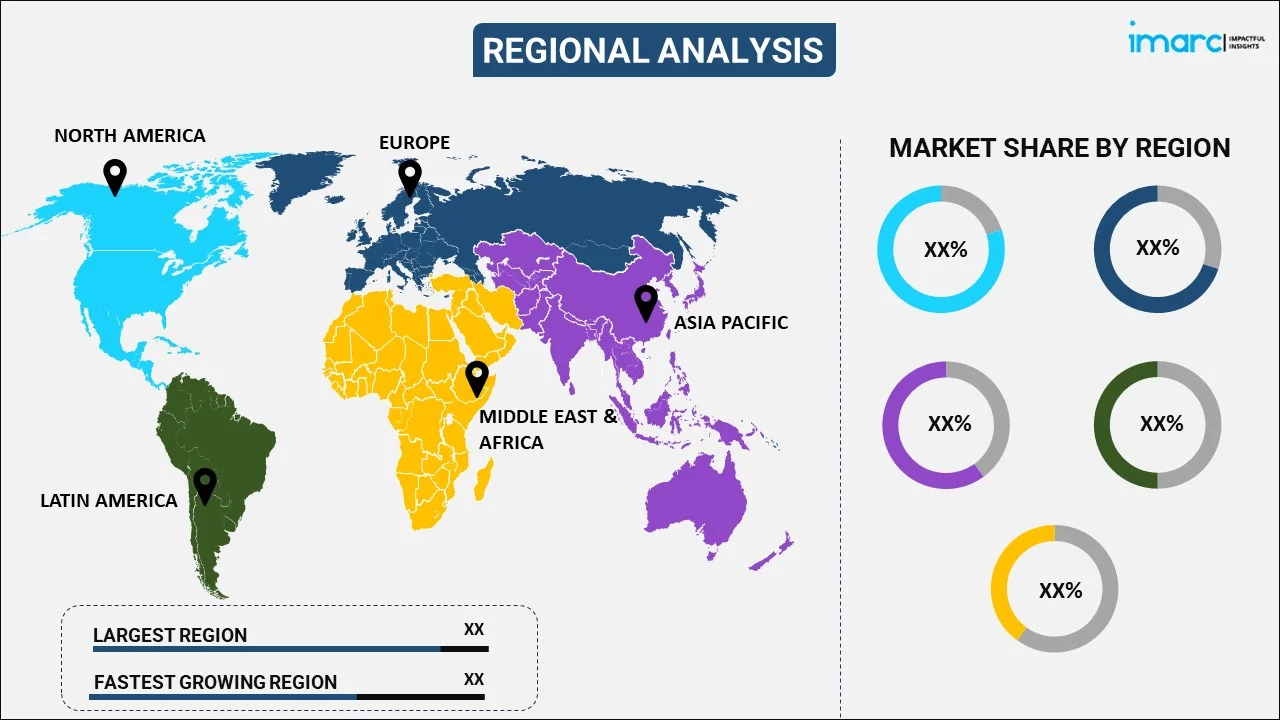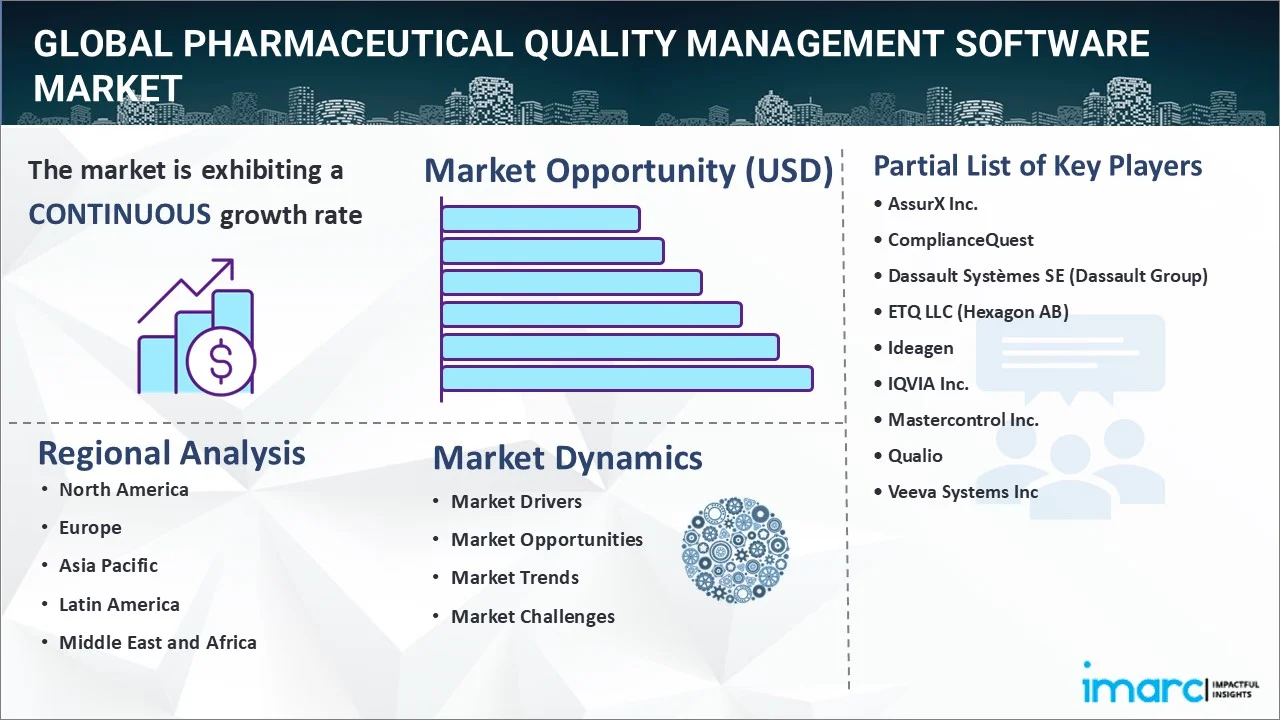
Pharmaceutical Quality Management Software Market Report by Solution Type (Corrective Action Preventive Action (CAPA) Management, Audit Management, Document Management, Change Management, Training Management, Risk Management, Complaints Management, Regulatory and Compliance Management, Non-Conformances Handling, Supplier Quality Management, Inspection Management, Equipment Management, and Others), Deployment Model (On-Cloud, Web-Based, On-Premises), Enterprise Size (Small and Medium-sized Enterprises, Large Enterprises), End User (Pharmaceutical, Life Sciences, and Biotechnology Companies, Contract Research Organizations, and Others), and Region 2025-2033
Global Pharmaceutical Quality Management Software Market:
The global pharmaceutical quality management software market size reached USD 1.4 Billion in 2024. Looking forward, IMARC Group expects the market to reach USD 2.9 Billion by 2033, exhibiting a growth rate (CAGR) of 8.9% during 2025-2033. The increasing digitization in the pharmaceutical sector and the growing requirement to comply with regulatory guidelines are stimulating the market.
|
Report Attribute
|
Key Statistics
|
|---|---|
|
Base Year
|
2024
|
|
Forecast Years
|
2025-2033
|
|
Historical Years
|
2019-2024
|
|
Market Size in 2024
|
USD 1.4 Billion |
|
Market Forecast in 2033
|
USD 2.9 Billion |
| Market Growth Rate 2025-2033 | 8.9% |
Pharmaceutical Quality Management Software Market Analysis:
- Major Market Drivers: The growing complication of supply chains, comprising various suppliers, manufacturers, and distributors, is propelling the market.
- Key Market Trends: The widespread adoption of digital solutions by pharmaceutical companies to secure quality management platforms is a significant growth-inducing factor in the pharmaceutical quality management software market value.
- Competitive Landscape: Some of the major market companies include AssurX Inc., ComplianceQuest, Dassault Systèmes SE (Dassault Group), ETQ LLC (Hexagon AB), Ideagen, IQVIA Inc., Mastercontrol Inc., and Qualio, Veeva Systems Inc., among many others.
- Geographical Trends: Rigorous regulatory requirements and the rising use of modern technologies, especially cloud-based solutions, are augmenting the market in North America.
- Challenges and Opportunities: Integrating new software with existing structures is hampering the market. However, implementing flexible and scalable solutions that facilitate smooth integration and are adaptive to changing regulatory needs will continue to catalyze the market over the forecast period.
Pharmaceutical Quality Management Software Market Trends:
Increase in Usage of Cloud-Based Solutions
Cloud-based quality management solutions are gaining popularity due to their flexibility, allowing pharmaceutical businesses to scale efficiently, offer remote access, and improve real-time collaboration without incurring significant upfront costs. In July 2024, Antares Vision Group launched DIAMIND Sentry, a solution designed to allow pharma companies to efficiently manage the substantial uptick in exceptions by streamlining collaboration and ensuring seamless regulatory compliance. The cloud-based platform allows manufacturers, wholesalers, and dispensers to identify and resolve product data exchange errors. This trend is largely adding to the pharmaceutical quality management software market share.
Implementation of Regulatory Compliance Automation
Automation of regulatory compliance within the quality management system is becoming more crucial as firms seek to eliminate manual effort and human mistake. Pharmaceutical companies can ensure compliance with the FDA and other global standards by automating document control, audit trails, and reporting. In April 2024, Clarivate Plc, a leading global provider of transformative intelligence, announced the acquisition of Global QMS, Inc., known as Global Q, a provider of cloud-based solutions that enable life sciences clients to automate regulatory reporting and compliance management. This trend is contributing to the pharmaceutical quality management software market statistics.
Widespread Integration with AI and Machine Learning
Artificial intelligence (AI) and machine learning (ML) improve quality management systems by automating quality operations, improving data analysis, and enabling predictive maintenance. These technologies assist in the early detection of trends and anomalies, allowing for quick corrective actions. In April 2024, Veeva Systems announced the Veeva AI Partner Program to provide partners with the advanced technology and support needed to integrate generative AI (GenAI) solutions seamlessly with Veeva Vault applications. This trend significantly helps in boosting the pharmaceutical quality management software market demand.
Global Pharmaceutical Quality Management Software Industry Segmentation:
IMARC Group provides an analysis of the key trends in each segment of the market, along with the pharmaceutical quality management software market forecasts at the global, regional, and country levels for 2025-2033. Our report has categorized the market based on solution type, deployment model, enterprise size, and end user.
Breakup by Solution Type:

- Corrective Action Preventive Action (CAPA) Management
- Audit Management
- Document Management
- Change Management
- Training Management
- Risk Management
- Complaints Management
- Regulatory and Compliance Management
- Non-Conformances Handling
- Supplier Quality Management
- Inspection Management
- Equipment Management
- Others
The report has provided a detailed breakup and analysis of the market based on the solution type. This includes corrective action preventive action (CAPA) management, audit management, document management, change management, training management, risk management, complaints management, regulatory and compliance management, non-conformances handling, supplier quality management, inspection management, equipment management, and others.
Corrective action preventive action (CAPA) management identifies and resolves issues before they escalate, while audit management optimizes internal and external audit processes to ensure regulatory compliance. Document management ensures that important data are stored securely and easily accessible, while change management monitors changes in processes and systems. Training management helps employees improve skills and comply with current requirements, while risk management examines and mitigates any operational risks. Complaints management effectively addresses consumer issues, while regulatory and compliance management ensures that firms remain compliant with ever-changing requirements. Non-conformances handling identifies and resolves variations in product or process quality, whereas supplier quality management ensures consistent performance from suppliers. Inspection management improves material quality control, while equipment management ensures that all tools and machines are kept in good working order and comply with regulations.
Breakup by Deployment Model:
- On-Cloud
- Web-Based
- On-Premises
The report has provided a detailed breakup and analysis of the market based on the deployment model. This includes on-cloud, web-based, and on-premises.
On-cloud solutions are gaining popularity due to their scalability, cost-effectiveness, and remote accessibility, making them suitable for businesses that prefer flexibility and real-time collaboration across geographies. Web-based deployments offer an accessible option that eliminates the need for extensive IT infrastructure, allowing users to oversee quality procedures from any web browser. On-premises models, while requiring more initial investment and upkeep, provide greater control over data protection and system flexibility. These segments significantly contribute to the pharmaceutical quality management software market growth.
Breakup by Enterprise Size:
- Small and Medium-sized Enterprises
- Large Enterprises
The report has provided a detailed breakup and analysis of the market based on the enterprise size. This includes small and medium-sized enterprises and large enterprises.
Small and medium-sized enterprises commonly prefer cost-effective, scalable solutions, such as cloud-based installations, to manage their quality processes without incurring significant upfront costs. Large enterprises, on the other hand, typically require more extensive and configurable systems, generally choosing on-premises or hybrid solutions that provide improved control, integration capabilities, and robust support for complicated regulatory and operational requirements. Both segments are effectively pushing the pharmaceutical quality management software market revenue.
Breakup by End User:
- Pharmaceutical, Life Sciences, and Biotechnology Companies
- Contract Research Organizations
- Others
Currently, pharmaceutical, life sciences, and biotechnology companies lead the pharmaceutical quality management software market outlook
The report has provided a detailed breakup and analysis of the market based on the end user. This includes pharmaceutical, life sciences, and biotechnology companies, contract research organizations, and others. According to the report, pharmaceutical, life sciences, and biotechnology companies represented the largest market segmentation.
Pharmaceutical, life sciences, and biotechnology companies prioritize compliance, risk management, and quality control throughout their operations. These businesses use quality management system technologies to streamline processes including manufacturing, research, clinical trials, and product development while adhering to stringent regulatory standards.
Breakup by Region:

- North America
- United States
- Canada
- Europe
- Germany
- France
- United Kingdom
- Italy
- Spain
- Russia
- Others
- Asia Pacific
- China
- Japan
- India
- South Korea
- Australia
- Indonesia
- Others
- Latin America
- Brazil
- Mexico
- Others
- Middle East and Africa
North America currently dominates the market
The pharmaceutical quality management software market research report has also provided a comprehensive analysis of all the major regional markets, which include North America (the United States and Canada); Europe (Germany, France, the United Kingdom, Italy, Spain, Russia, and others); Asia Pacific (China, Japan, India, South Korea, Australia, Indonesia, and others); Latin America (Brazil, Mexico, and others); and the Middle East and Africa. According to the report, North America accounted for the largest market share.
North America exhibits a clear dominance in the pharmaceutical quality management software market overview owing to its advanced healthcare infrastructure, strict laws and regulations, and quick adoption of technology. The region's emphasis on enhancing operational efficiency, assuring drug safety, and reducing compliance risks promotes investment in sophisticated quality management software.
Competitive Landscape:
The report has provided a comprehensive analysis of the competitive landscape. Detailed profiles of all major market pharmaceutical quality management software companies have also been provided. Some of the key players in the market include:
- AssurX Inc.
- ComplianceQuest
- Dassault Systèmes SE (Dassault Group)
- ETQ LLC (Hexagon AB)
- Ideagen
- IQVIA Inc.
- Mastercontrol Inc.
- Qualio
- Veeva Systems Inc
(Please note that this is only a partial list of the key players, and the complete list is provided in the report.)
Pharmaceutical Quality Management Software Market Recent Developments:
- July 2024: Antares Vision Group launched DIAMIND Sentry, a solution designed to allow pharma companies to efficiently manage the substantial uptick in exceptions by streamlining collaboration and ensuring seamless regulatory compliance. The cloud-based platform allows manufacturers, wholesalers, and dispensers to identify and resolve product data exchange errors.
- April 2024: Clarivate Plc, a leading global provider of transformative intelligence, announced the acquisition of Global QMS, Inc., known as Global Q, a provider of cloud-based solutions that enable life sciences clients to automate regulatory reporting and compliance management.
- April 2024: Veeva Systems announced the Veeva AI Partner Program to provide partners with the advanced technology and support needed to integrate generative AI (GenAI) solutions seamlessly with Veeva Vault applications.
Pharmaceutical Quality Management Software Market Report Scope:
| Report Features | Details |
|---|---|
| Base Year of the Analysis | 2024 |
| Historical Period | 2019-2024 |
| Forecast Period | 2025-2033 |
| Units | Billion USD |
| Scope of the Report | Exploration of Historical Trends and Market Outlook, Industry Catalysts and Challenges, Segment-Wise Historical and Predictive Market Assessment:
|
| Solution Types Covered | Corrective Action Preventive Action (CAPA) Management, Audit Management, Document Management, Change Management, Training Management, Risk Management, Complaints Management, Regulatory and Compliance Management, Non-Conformances Handling, Supplier Quality Management, Inspection Management, Equipment Management, Others |
| Deployment Models Covered | On-Cloud, Web-Based, On-Premises |
| Enterprise Sizes Covered | Small and Medium-sized Enterprises, Large Enterprises |
| End Users Covered | Pharmaceutical, Life Sciences, and Biotechnology Companies, Contract Research Organizations, Others |
| Regions Covered | Asia Pacific, Europe, North America, Latin America, Middle East and Africa |
| Countries Covered | United States, Canada, Germany, France, United Kingdom, Italy, Spain, Russia, China, Japan, India, South Korea, Australia, Indonesia, Brazil, Mexico |
| Companies Covered | AssurX Inc., ComplianceQuest, Dassault Systèmes SE (Dassault Group), ETQ LLC (Hexagon AB), Ideagen, IQVIA Inc., Mastercontrol Inc., Qualio, Veeva Systems Inc, etc. |
| Customization Scope | 10% Free Customization |
| Post-Sale Analyst Support | 10-12 Weeks |
| Delivery Format | PDF and Excel through Email (We can also provide the editable version of the report in PPT/Word format on special request) |
Key Questions Answered in This Report:
- How has the global pharmaceutical quality management software market performed so far, and how will it perform in the coming years?
- What are the drivers, restraints, and opportunities in the global pharmaceutical quality management software market?
- What is the impact of each driver, restraint, and opportunity on the global pharmaceutical quality management software market?
- What are the key regional markets?
- Which countries represent the most attractive pharmaceutical quality management software market?
- What is the breakup of the market based on the solution type?
- Which is the most attractive solution type in the pharmaceutical quality management software market?
- What is the breakup of the market based on the deployment model?
- Which is the most attractive deployment model in the pharmaceutical quality management software market?
- What is the breakup of the market based on enterprise size?
- Which is the most attractive enterprise size in the pharmaceutical quality management software market?
- What is the breakup of the market based on the end user?
- Which is the most attractive end user in the pharmaceutical quality management software market?
- What is the competitive structure of the global pharmaceutical quality management software market?
- Who are the key players/companies in the global pharmaceutical quality management software market?
Key Benefits for Stakeholders:
- IMARC's industry report offers a comprehensive quantitative analysis of various market segments, historical and current market trends, market forecasts, and dynamics of the pharmaceutical quality management software market from 2019-2033.
- The research report provides the latest information on the market drivers, challenges, and opportunities in the global pharmaceutical quality management software market.
- The study maps the leading, as well as the fastest-growing, regional markets. It further enables stakeholders to identify the key country-level markets within each region.
- Porter's five forces analysis assists stakeholders in assessing the impact of new entrants, competitive rivalry, supplier power, buyer power, and the threat of substitution. It helps stakeholders to analyze the level of competition within the pharmaceutical quality management software industry and its attractiveness.
- The competitive landscape allows stakeholders to understand their competitive environment and provides insight into the current positions of key players in the market.
Need more help?
- Speak to our experienced analysts for insights on the current market scenarios.
- Include additional segments and countries to customize the report as per your requirement.
- Gain an unparalleled competitive advantage in your domain by understanding how to utilize the report and positively impacting your operations and revenue.
- For further assistance, please connect with our analysts.

 Inquire Before Buying
Inquire Before Buying
 Speak to an Analyst
Speak to an Analyst
 Request Brochure
Request Brochure
 Request Customization
Request Customization




.webp)




.webp)












